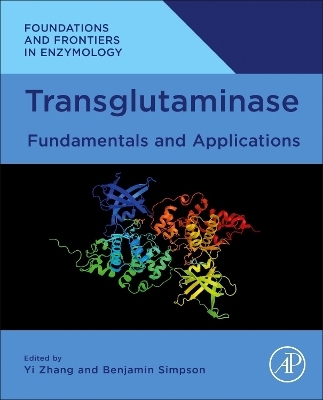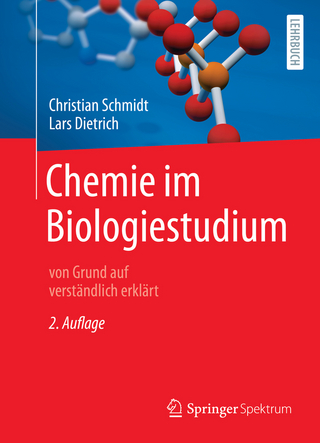
Transglutaminase
Academic Press Inc (Verlag)
978-0-443-19168-8 (ISBN)
Research protocols are also provided, including research rationale, design, substrates, assays, and microassay steps for studying transglutaminases.
Dr. Yi Zhang received her BSc & MSc at Ocean University of China, and her PhD & postdoctoral training at McGill University, Canada. She was a Commonwealth Blue Charter Fellow. To-date, Dr. Zhang has published 30 papers and 5 book chapters in the areas of enzymology, agricultural biochemistry, and biological sciences. Professor Benjamin Simpson is a graduate in Biochemistry from Memorial University of Newfoundland, where he also carried out postdoctoral work till December 1985. He joined the Food Science Department at McGill in June 1987 after spending a period of time at the Institute of Food & Agricultural Sciences (IFAS), University of Florida at Gainesville in the USA, as a Research Associate from January 1986 to April, 1987. His research program involves the post-mortem biochemistry of marine organisms, in relation to enzymes. Specifically on digestive enzymes from marine animals, their characterization to discover their unique properties that may make them better suited for particular applications compared with their traditional counterparts; role of enzymes in color and texture deterioration in fish and shellfish and development of strategies to control the deleterious effects of enzymes in foods during processing and storage; and the use of enzymes in transforming discards from food harvesting / processing into value added products of commercial relevance. Examples of the value-added products prepared by the enzyme assisted procedures include natural food pigments, proteins, bioactive peptides, flavor compounds and chitin, etc., for use as food processing aids. Dr. Simpson is responsible for teaching Food Commodities, Food Chemistry 2 and Enzymology.
An introduction to transglutaminases
Yi Zhang, Srividya Parthasarathy, and Benjamin K. Simpson
Chapter 1 Transglutaminases from microorganisms
Limin Wang and Yi Wang
1. Introduction
2. Microbial sources of TGase
3. Biotechnological production of MTGase
4. Concluding remarks and outlook
References
Chapter 2 Transglutaminases from plant sources
Stefano Del Duca and Giampiero Cai
1. Introduction
2. Phylogenetic relationship and bioinformatic analyses
3. Distribution and physiological roles of TGases in plants
4. Conclusions
References
Chapter 3 Transglutaminases from animals
Jirawat Yongsawatdigul, Ali Hamzeh and Bung-orn Hemung
1. Introduction
2. Function and distribution
3. Conclusions
References
Chapter 4 Newly engineered transglutaminases
Han Liu, Ishita Ghosh, Corinne Nardin and Yi Zhang
1. Introduction
2. Methodology for engineering transglutaminases
3. Newly engineered microbial transglutaminases
4. Newly engineered animal transglutaminases
5. Regulations
References
Chapter 5 Transglutaminase 2 in neurological conditions
Thomas Delgado and Gail V.W. Johnson
1. Discovery of TG2 and its association with proteinopathies
2. TG2’s complex role in neuron survival
3. TG2 in CNS injury and neuroinflammation
4. Epigenetic regulation by TG2
5. Conclusions
References
Chapter 6 Transglutaminases in cardiovascular health and disease
Lakshmi Santhanam
Abbreviations
1. Introduction
2. Transglutaminases in the cardiovascular system
3. Transglutaminases in vascular diseases
4. Transglutaminases in cardiac disease
5. Transglutaminases in thromboembolism
6. Conclusions and future perspectives
References
Chapter 7 Microbial transglutaminase in drug development
Riko Nishioka, Ryo Sato, Kazuki Uchida, Rie Wakabayashi and Noriho Kamiya
1. Introduction
2. Protein modification using small molecule substrates
3. Preparation of proteineprotein conjugates
4. Protein modification using synthetic polymeric substrates
5. Introduction of hydrophobic molecules into proteins
6. Conclusion
Acknowledgments
References
Chapter 8 Transglutaminases in meat and seafood bioprocessing
Pınar Yerlikaya and Nalan Gokoglu
1. Transglutaminases in meat bioprocessing
2. Transglutaminases in seafood bioprocessing
3. Conclusion
References
Chapter 9 Transglutaminase in dairy processing
Ehab Romeih, Marek Kieliszek and Essam Hebishy
1. Introduction
2. MTGase applications in dairy processing
3. Conclusions and future remarks
References
Chapter 10 Transglutaminase in noodles, pastas, and baked products
Seyed Mohammad Taghi Gharibzahedi and Zeynep Altintas
1. Introduction
2. Noodle and TGase
3. Pasta and TGase
4. Bread and TGase
5. Other bakery products and TGase
6. Health and nutritional properties
7. Conclusions
Acknowledgments
References
Chapter 11 Transglutaminase in textile, wool, silk, and leather processing
Ning Zhang, Penghui Yang, Man Zhou, Qiang Wang, Song Liu and Jian Chen
1. Transglutaminase in wool processing
2. Transglutaminase in silk processing
3. Transglutaminase in leather processing
4. Conclusion
References
Chapter 12 Immobilization of transglutaminases and transglutaminase as immobilization agent
Katja Vasic, Zeljko Knez and Maja Leitgeb
1. Introduction
2. Enzymatic properties of TGase
3. Production and substrate preference of TGase
4. TGase immobilization
5. TGase as immobilizing agent in food and
biotechnology industries
6. Conclusions
Acknowledgments
References
Chapter 13 Industrial production of transglutaminase
Keiichi Yokoyama
1. Background to food innovation with transglutaminase
2. Feasibility study on protein modification by TGase
3. Search for a TGase for industrial applications
4. Developments for MTGase commercialization
5. MTGase in nature
6. Recombinant production of MTGase
7. MTGase variants with improved properties
8. Food safety and regulation
9. Concluding remarks
References
Further reading
Index
| Erscheinungsdatum | 09.03.2024 |
|---|---|
| Reihe/Serie | Foundations and Frontiers in Enzymology |
| Verlagsort | San Diego |
| Sprache | englisch |
| Maße | 191 x 235 mm |
| Gewicht | 810 g |
| Themenwelt | Naturwissenschaften ► Biologie ► Biochemie |
| Naturwissenschaften ► Physik / Astronomie ► Angewandte Physik | |
| Technik ► Umwelttechnik / Biotechnologie | |
| ISBN-10 | 0-443-19168-9 / 0443191689 |
| ISBN-13 | 978-0-443-19168-8 / 9780443191688 |
| Zustand | Neuware |
| Informationen gemäß Produktsicherheitsverordnung (GPSR) | |
| Haben Sie eine Frage zum Produkt? |
aus dem Bereich


